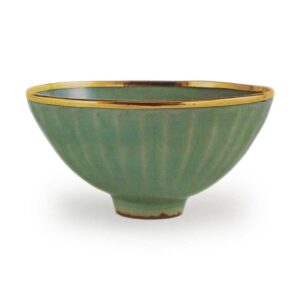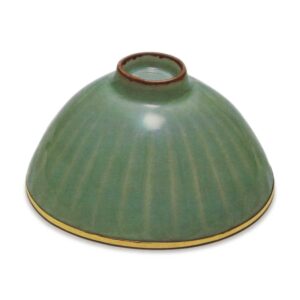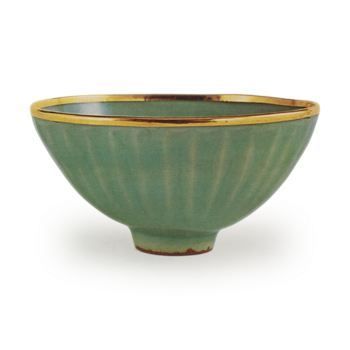

Fujita Art Museum
Height: 6.3cm
Diameter: 12.5cm
Outer diameter of foot: 3.5cm
Height of foot: 1.0cm
Celadon tea bowls were very popular in the past, but surprisingly few examples have survived to the present day. Probably, after the Edo period, they were rarely used in tea ceremonies, so they were lost or broken, and the number of them has decreased. For that reason, this tea bowl is also highly valuable, but more than that, the beauty of its shape and glaze is unsurpassed.
The clay used is a fine, hard clay that should be considered the best even at the Longquan kilns. The unglazed part with the tatami mat is burnt to a very dark brown. The bowl body, which is made on a fast, clean potter’s wheel, has a soft curve and is also quite thin, which is unusual. The foot ring is also thinly carved, and the sharp, careful finish is almost enough to make you think it’s a piece of celadon from the Guan kilns. On the outside of the bowl, there are thirty fine lotus petal carvings, and the sharpness of the carving, which is perfectly straight, is astonishing. Of course, they were carved freehand.
The glaze is then applied to the top of this, and it is also beautiful. It is said that the perfection of celadon was achieved during the Song dynasty.
The key point is that the celadon glaze, which had previously only been applied once, was applied twice or even three times. The glaze layer became thicker, so the glaze color became deeper and richer, and the luster became more abundant. The glaze on this tea bowl also shows the exuberant refinement of the period of its completion. There is a section on the outside of the bowl, slightly above the middle, where the glaze is a darker color, and this is where the glaze has pooled from being applied in layers. It looks like a patch of clouds.
The glaze disappears near the base, but it is probably because this section was lightly scraped after being applied in a single layer. So the glaze extends over the entire foot ring, making the raised center, or so-called kabuto-kin, look even more beautiful. The glaze is a beautiful light blue, commonly called powder blue, and is quite different from the greenish colors often seen in later pieces. It is as if you are trying to polish a gem. Both the exterior, which is covered with a pattern of ridges, and the interior, which is a single color with no cloudiness, are magnificent.
The rim is surrounded by a border of high-purity gold, but this bowl was not fired upside down, so the rim should not be rough, and in fact it probably did not need to be.
Nevertheless, the fact that it has a border suggests that it was considered to be a “celadon tenmoku” or a tenmoku tea bowl, as the note on the box says, and so it was probably done in accordance with the rules for tenmoku. I’d like to take it off and have a look at the rim.
The fact that this is a tenmoku tea bowl is known from the fact that it is accompanied by two tenmoku stands, one made of beautiful red lacquer and the other of black lacquer, both from the early Ming period. The lid of the round inner box is inscribed with the character “満月” (full moon) in the handwriting of Ryōryōsai. It is a famous bowl that is as full and well-rounded as a full moon.



